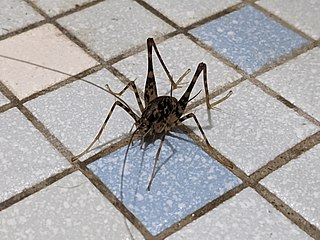
Penguins are a group of aquatic flightless birds. They live almost exclusively in the Southern Hemisphere, with only one species, the Galápagos penguin, found north of the Equator. Highly adapted for life in the water, penguins have countershaded dark and white plumage and flippers for swimming. Most penguins feed on krill, fish, squid and other forms of sea life which they catch while swimming underwater. They spend roughly half of their lives on land and the other half in the sea.

Taiga, generally referred to in North America as boreal forest or snow forest, is a biome characterized by coniferous forests consisting mostly of pines, spruces, and larches.

The International Union for Conservation of Nature (IUCN) Red List of Threatened Species, founded in 1964, is the world's most comprehensive inventory of the global conservation status of biological species. It uses a set of criteria to evaluate the extinction risk of thousands of species and subspecies. These criteria are relevant to all species and all regions of the world. With its strong scientific base, the IUCN Red List is recognized as the most authoritative guide to the status of biological diversity. A series of Regional Red Lists are produced by countries or organizations, which assess the risk of extinction to species within a political management unit.

The orthopteran family Rhaphidophoridae of the suborder Ensifera has a worldwide distribution. Common names for these insects include the cave wētā, cave crickets, camelback crickets, camel crickets, spider crickets and sand treaders. Those occurring in New Zealand, Australia, and Tasmania are typically referred to as jumping or cave wētā. Most are found in forest environments or within caves, animal burrows, cellars, under stones, or in wood or similar environments. All species are flightless and nocturnal, usually with long antennae and legs. More than 1100 species of Rhaphidophoridae are described.

Monkey is a common name that may refer to groups or species of mammals, in part, the simians of infraorder Simiiformes. The term is applied descriptively to groups of primates, such as families of New World monkeys and Old World monkeys. Many monkey species are tree-dwelling (arboreal), although there are species that live primarily on the ground, such as baboons. Most species are mainly active during the day (diurnal). Monkeys are generally considered to be intelligent, especially the Old World monkeys of Catarrhini.
Hwanseon Cave (환선굴) is a cave located in Gangwon province, South Korea. It is one of the largest limestone caves in Asia, and the biggest in Korea, with 6.2 km of known passages and a total suspected length of 8 km, 1.6 km of which are visited by over 1 million people per year. In 1966 the South Korea government designated this cave and a neighboring cave not open to the public, Gwaneum cave (관음굴), National Monument 178. Hwanseongul was opened to the public in 1997.
Diestrammena is a 'camel' or 'cave-cricket' genus in the family Rhaphidophoridae. Species in the genus are native to Asia, including Japan.
iNaturalist is a social network of naturalists, citizen scientists, and biologists built on the concept of mapping and sharing observations of biodiversity across the globe. iNaturalist may be accessed via its website or from its mobile applications. As of February 2021, iNaturalist users had contributed approximately 66 million observations of plants, animals, fungi, and other organisms worldwide, and around 130,000 users were active in the previous 30 days.
Tachycines (Gymnaeta) bifurcatus is a species of camel cricket in the Aemodogryllinae subfamily. This species was first described in 2010 by Gorochov, under its synonym Diestrammena bifurcata.
Weissella diestrammenae is a Gram-positive, facultatively anaerobic and non-motil bacterium from the genus of Weissella which has been isolated from the gut of the camel cricket Diestrammena coreana in Korea.

The Orthopteran subfamily Aemodogryllinae contains about sixteen genera of camel crickets. It was named after AemodogryllusAdelung, 1902 - which is now considered a subgenus of Diestrammena.
Diestramima is a genus of camel crickets in the subfamily Aemodogryllinae and tribe Diestramimini. Species can be found in: India, southern China and Indo-China.

Tachycines is a genus of camel crickets in the subfamily Aemodogryllinae and tribe Aemodogryllini. Some authorities had placed the type species, T. asynamorus, in the genus Diestrammena, but recent papers returned this to the subgenus Tachycines (Tachycines), with a substantial number of new species recently described.

Tachycines asynamorus is a cave cricket and the type species of the genus Tachycines (Rhaphidophoridae). In English-speaking countries it is known as the greenhouse camel cricket or greenhouse stone cricket for its propensity for living in greenhouses. It was first described in 1902 by Russian entomologist Nicolai Adelung. Some authorities have placed this species in the genus Diestrammena, but it has now restored to its basonym.
Eutachycines is a genus of cave or camel crickets in the subfamily Aemodogryllinae and tribe Aemodogryllini. Originating in Asia, species have been found in Sri Lanka, southern China, Indo-China and west Malesia.
Paradiestrammena is a genus of cave or camel crickets in the subfamily Aemodogryllinae and tribe Aemodogryllini. Originating in Asia, species have been found in Borneo, the Indo-China region and Japan.

Atachycines is a genus of cave or camel crickets in the subfamily Aemodogryllinae; the genus has not been assigned to any tribe. Originating in Asia, species have been found in Borneo, the Indo-China region and Japan.

The Japanese camel cricket, Diestrammena japanica is a species of camel cricket native to Japan. Outside of its native range, specifically in the eastern United States, it is recognized as an invasive species.







